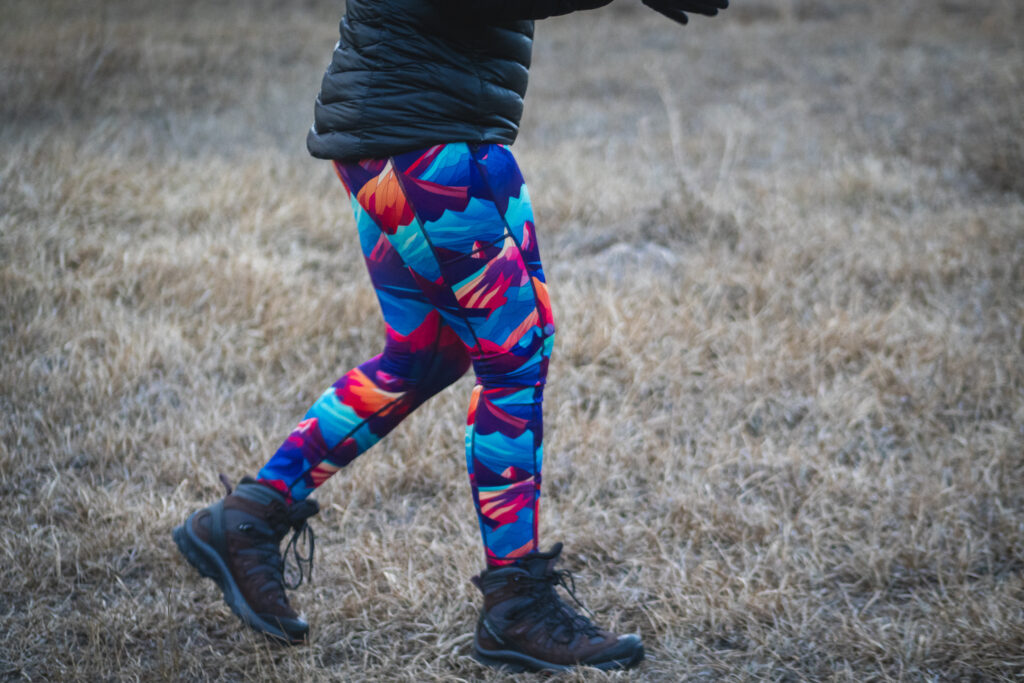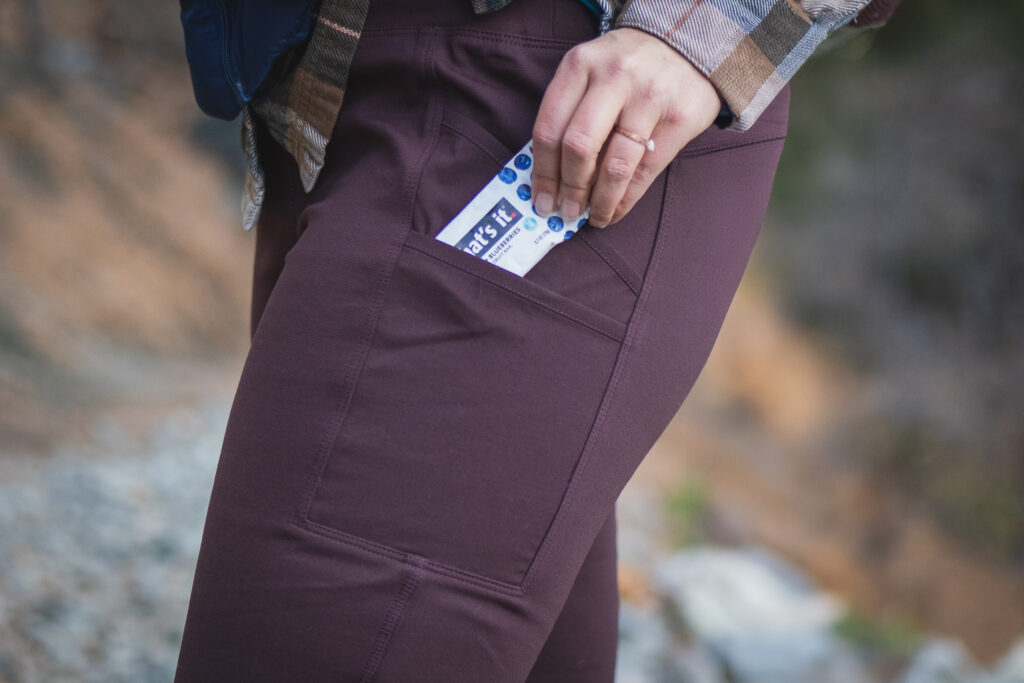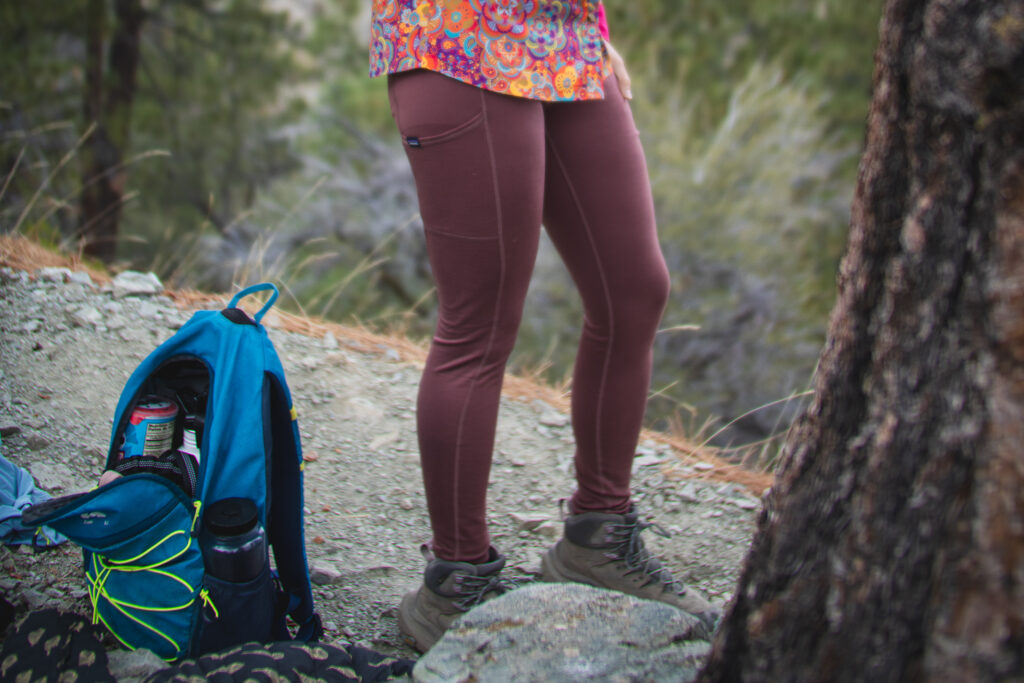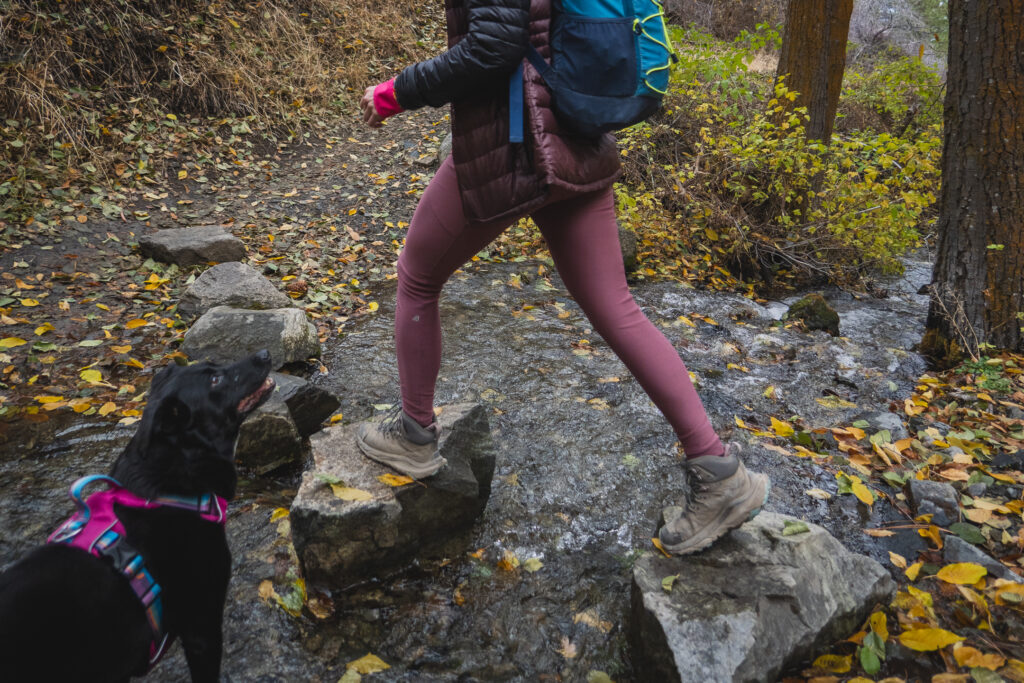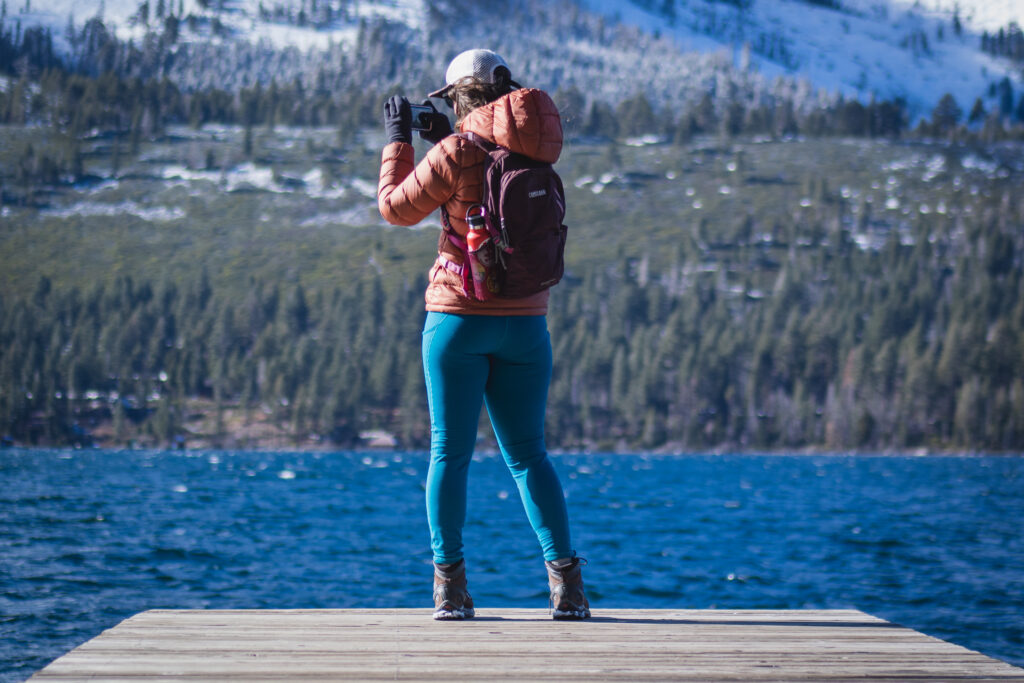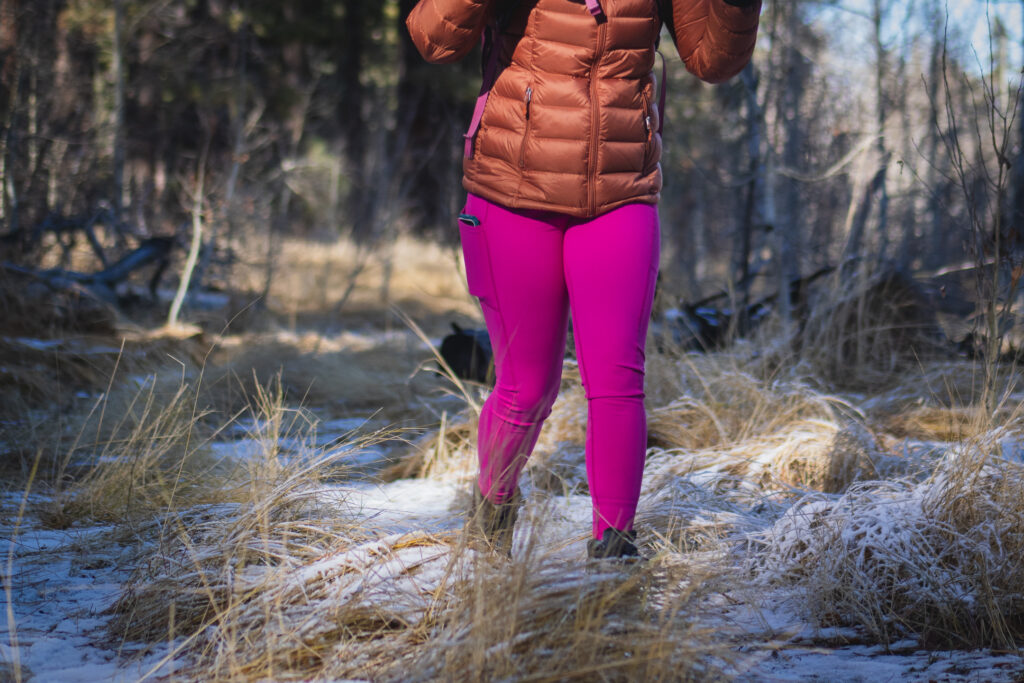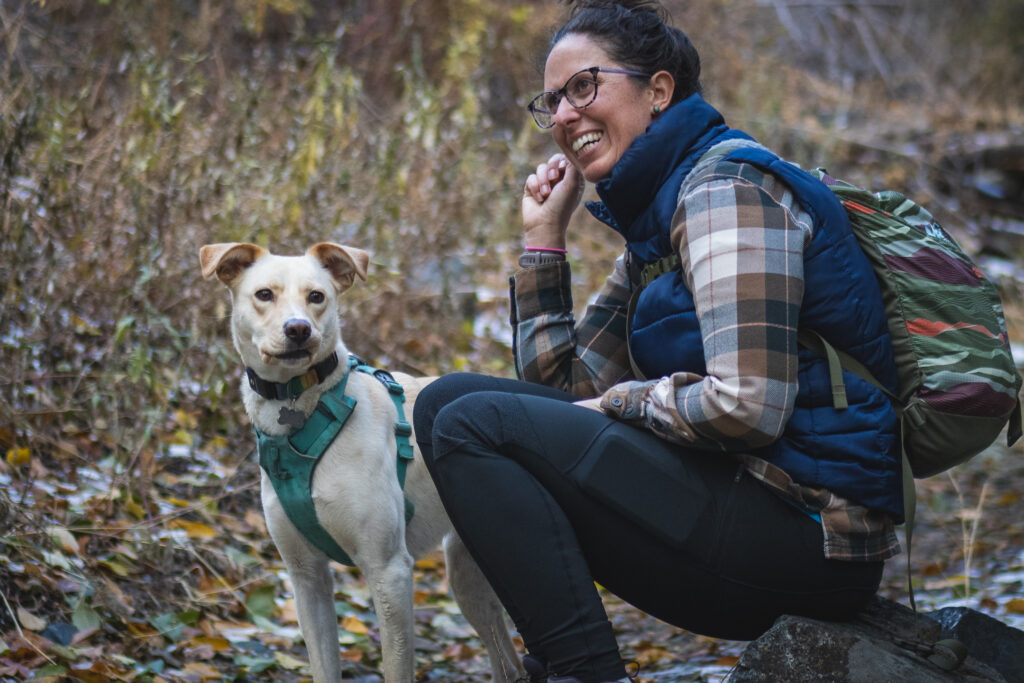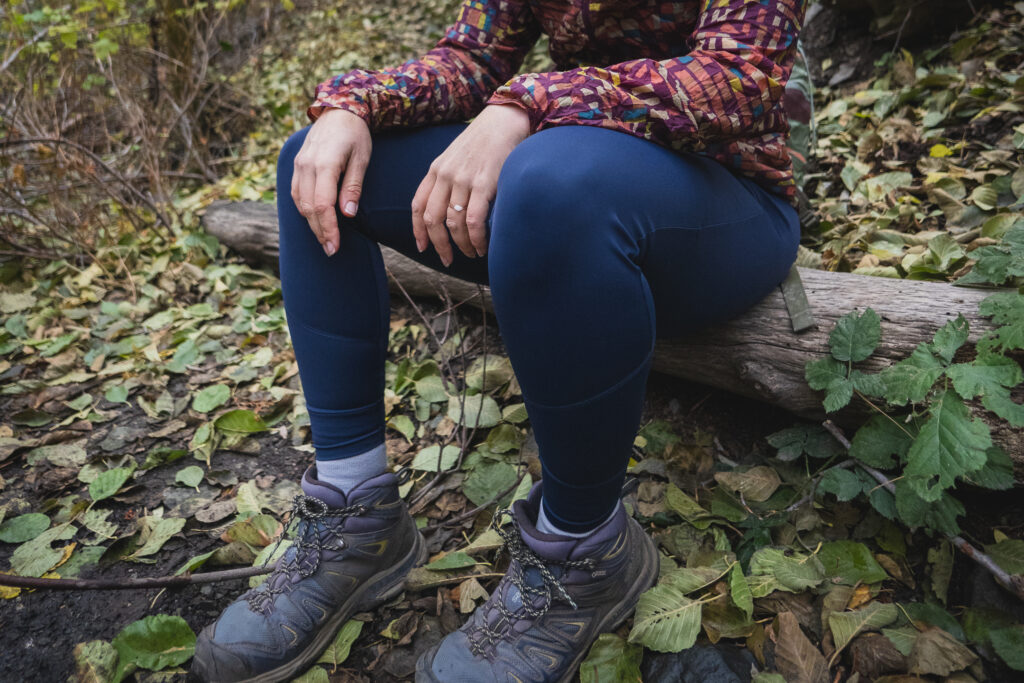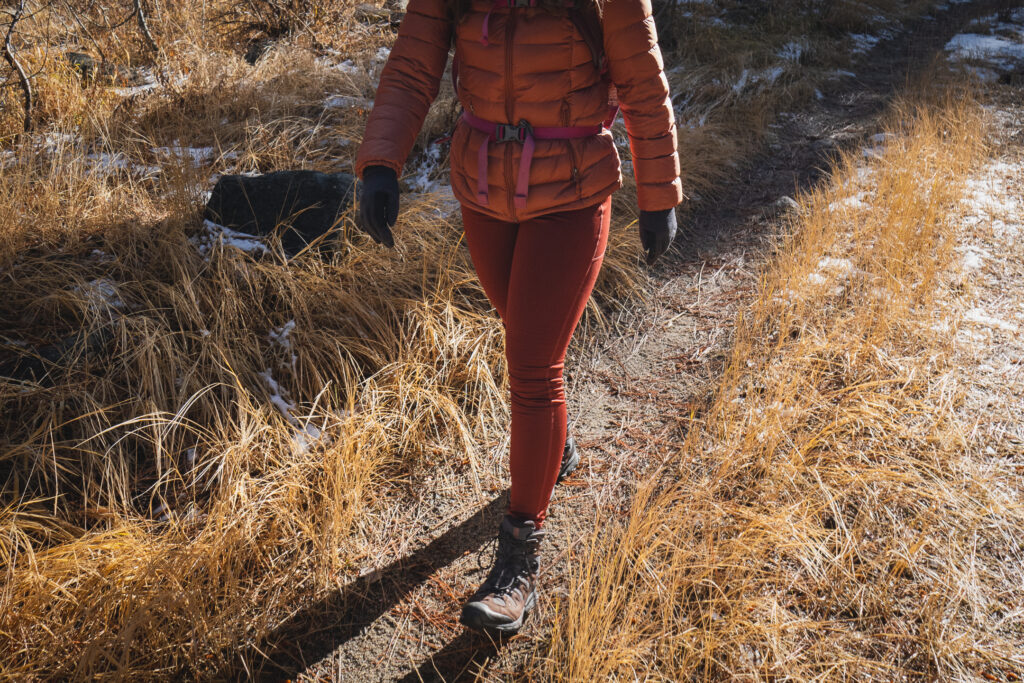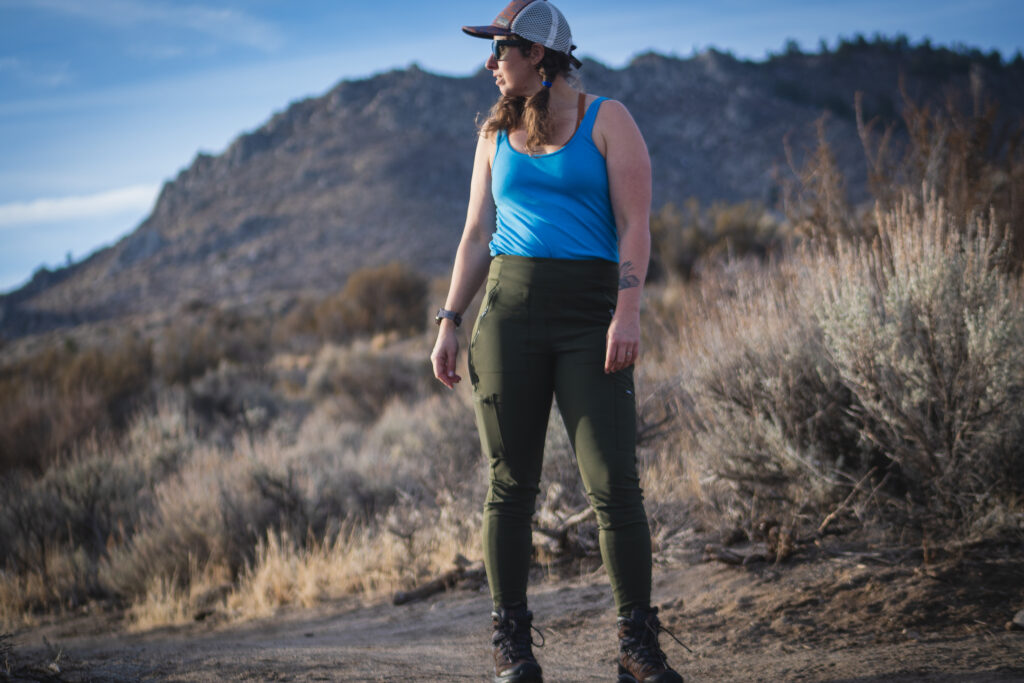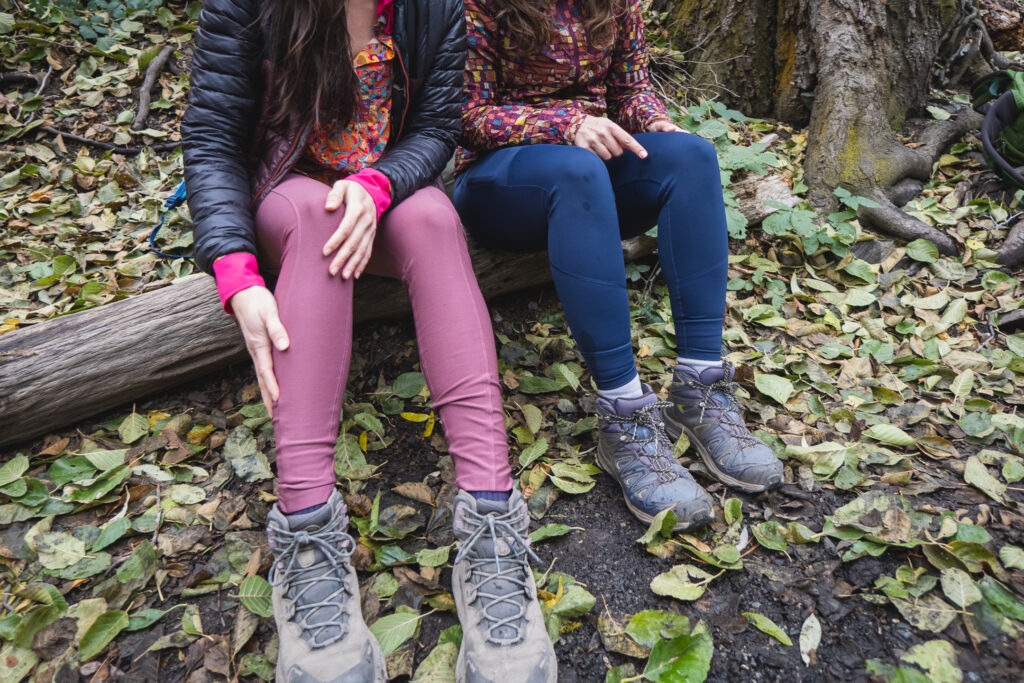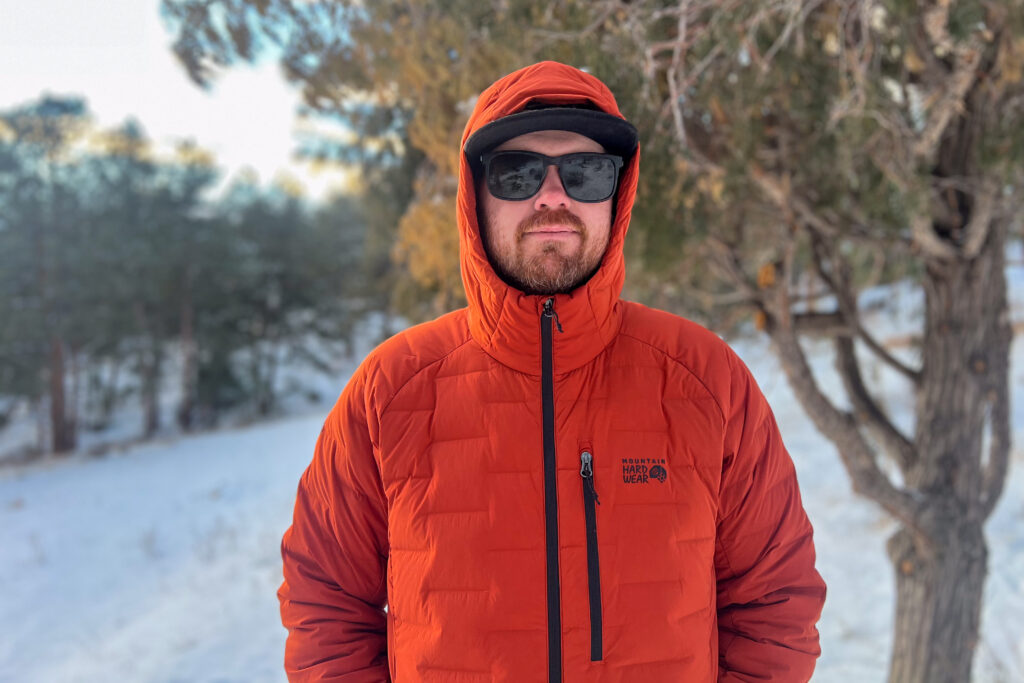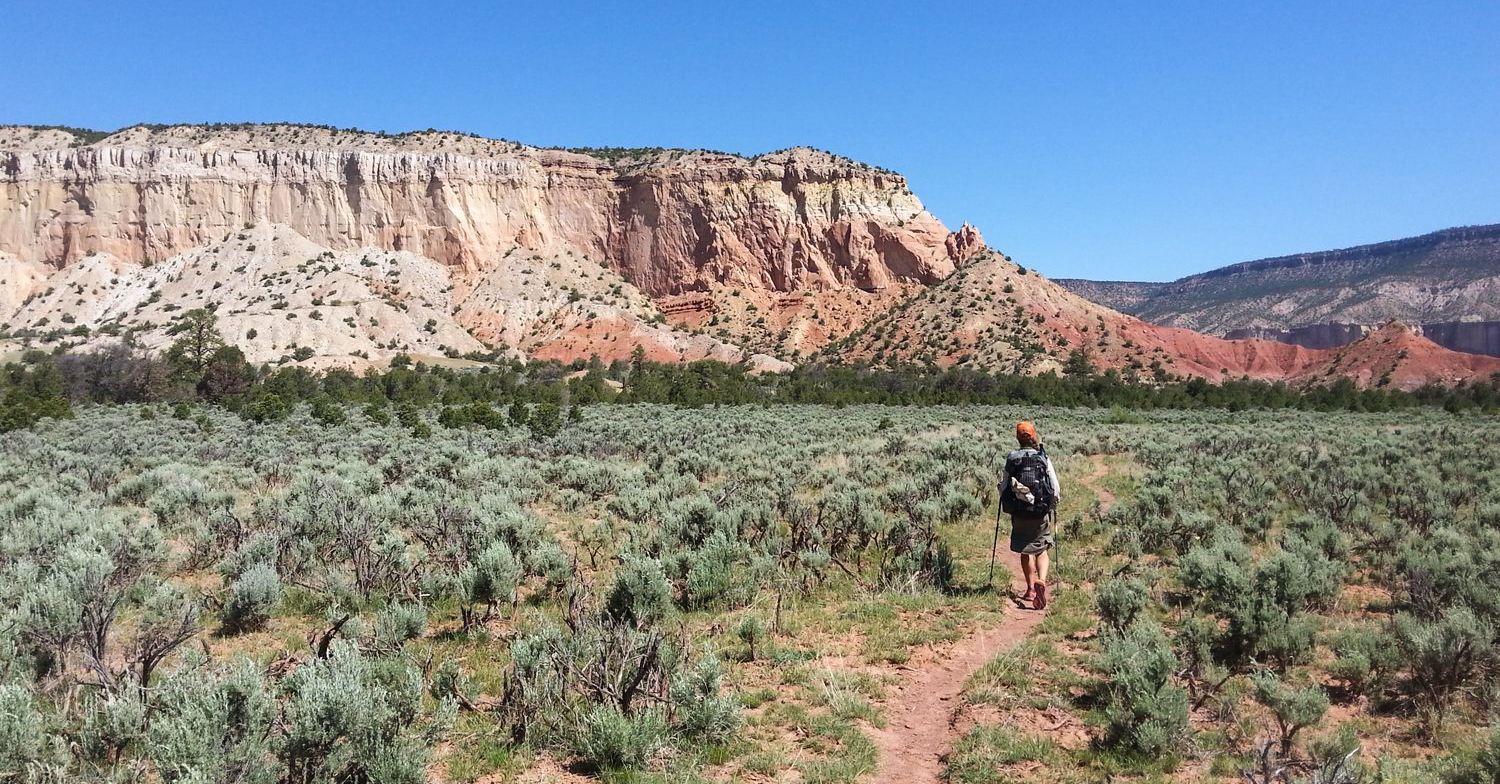
It may not always look like it, but deserts are dynamic ecosystems full of unique plants, wildlife, and geological features (super cool rocks). These places are also more accessible to those looking for trip options in winter, early spring, and late fall when snow covers most mountainous areas.
However, desert hiking is not for the faint of heart. Backpacking in the badlands can be dangerous and uncomfortable, but for those who enjoy a challenge (and are willing to share water with cows), the desert holds true, rugged beauty and adventure. Our tips – developed and practiced over 4,000 miles of desert hiking – will help you stay comfortable, happy, and safe as you move through the awe-inspiring landscapes that arid trails have to offer.
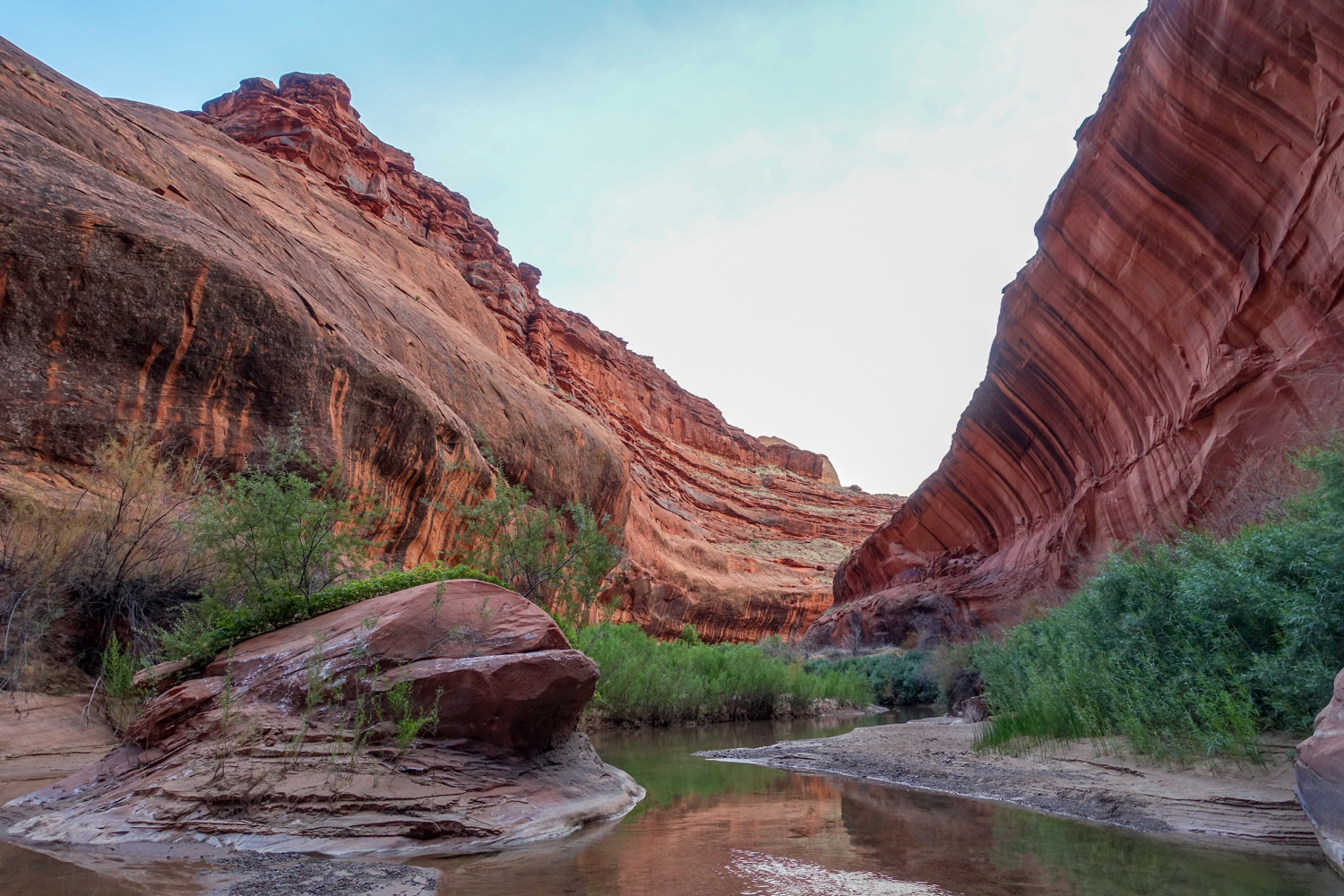
Beat the Heat
Deserts are not definitionally hot, but most of them are. Thermoregulation – staying cool and shaded – is tricky but essential. Learn the signs of heat stroke/exhaustion and be confident that you’ll know what to do if things go to hell in a hand basket.
1. Start Early
In summertime, desert trails can be scorching hot by 10am or earlier. To take full advantage of cooler early mornings, plan to break camp as close to dawn as possible, even if that means waking up before the sun rises. Try to hike about half of your miles before the heat of the day becomes oppressive. The desert is usually hottest between the hours of 10am and 4pm, so being on the move by 5-6am will set you up for success later on.
2. Hike Late
The same logic applies as the sun is going down. Hiking in the evening or even at night can be a fun and productive way to get miles in while temperatures are more tolerable. Your body doesn’t have to work as hard or require as much water and nighttime hiking can be especially enchanting if the moon is bright. Having said that, be safe and use common sense. If you are alone, are uncomfortable navigating in the dark, or do not have proper illumination, we do not recommend hiking into the night – getting lost in the desert is definitely not worth it.
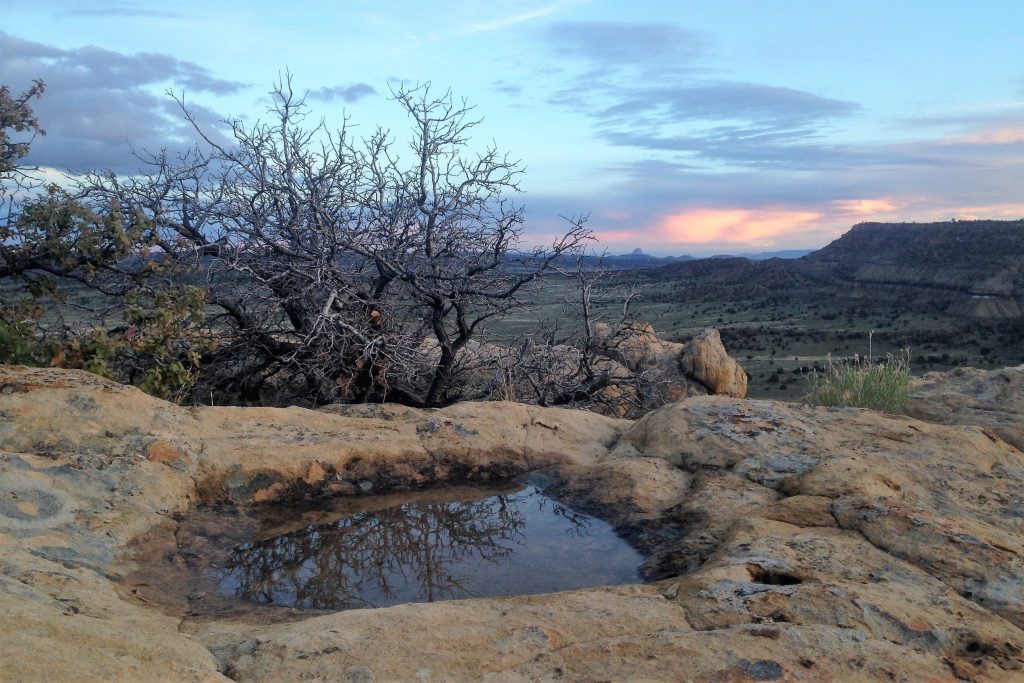
3. Take “Siestas”
A siesta – an afternoon rest or nap – is an approach taken by many desert hikers. As the angle of the sun increases and the temperature soars, you may notice your energy dwindling by late morning or early afternoon. This is normal. Instead of pushing on into the sweltering heat, it’s a smart idea to take a long break during the hottest part of the day to conserve your energy and let your body recover for a couple hours. It is important to find (or create) a shady place where you can relax and take shelter from the direct sun. Trees can be hard to come by in the desert, but many trails have that iconic shade tree at mile x. Plan your day around it, we’re serious. Many backpackers like to use this time to eat lunch, nap, read maps, and air out their feet. While it is ideal to take a break like this close to a water source, it may not always be possible.
4. Get Wet
When the opportunity presents itself, soak the clothing you are wearing with water. Even if the water isn’t cold, it will still cool you down. Tying a wet bandana around your neck is an effective way to help lower your temperature, as your blood passes through your carotid artery there on its way to your head.
It is best to do this at a water source instead of using your drinking water to douse your clothes – just make sure you are following LNT protocol. Always be mindful of other hikers who may be following in your footsteps and be extremely careful not to contaminate water sources with your sweat and foot funk. Never dip your clothing directly in a water source.
Though the opportunities can be few and far between, when you come across a lake or river, immerse your feet, head, or entire body to aggressively cool yourself.

5. Take & Make Shade
If you’re stopping for more than just a moment, seek shade. It may not always look like a nice spot – maybe it’s the silhouette of a large rock, the deep crevice of an arroyo, or dappled shade created by tall brush. We’ve spent our fair share of time rolled up under junipers and curled up in the evaporating shadows of a deep wash. However slight, taking shelter will prevent you from absorbing extra heat while you read your map, get into your pack, or eat a snack.
Some long-distance hikers to use an umbrella like the Lightrek Hiking Chrome Umbrella as portable shade for desert hiking. This lightweight gear is an easy way to add significant sun protection on the move and will keep you cooler longer than even the best sun hat. In high wind, deploy yours at your own risk, but they certainly make hiking in direct sun more comfortable.
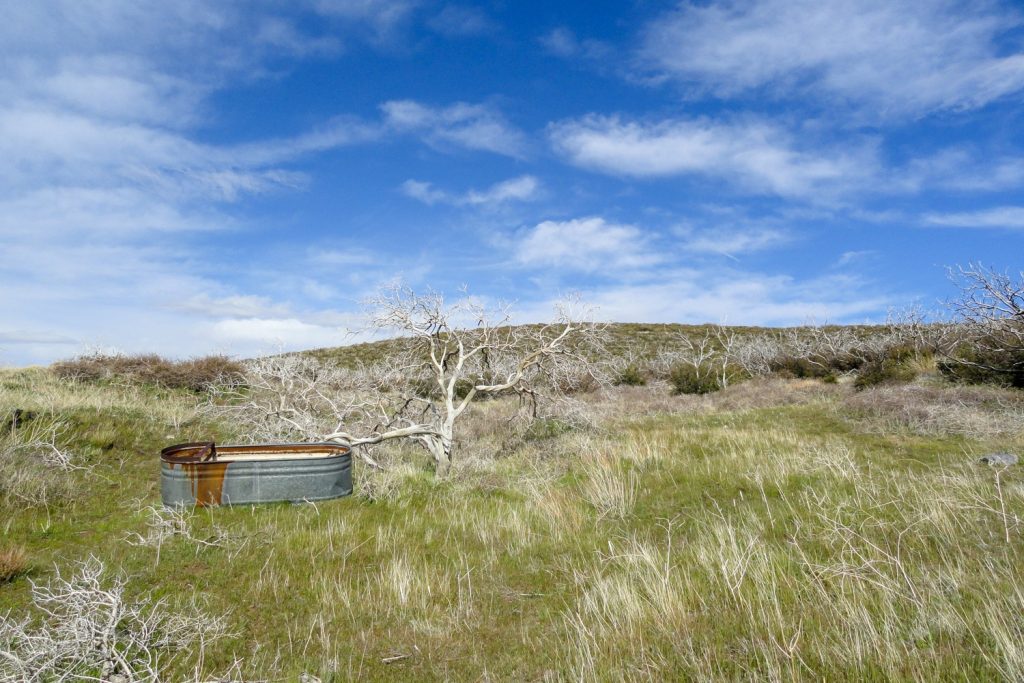
Stay Hydrated
6. Plan Ahead & Prepare
An arid desert pulls moisture off of your skin and can dehydrate you extremely quickly. For this reason, it is critical to drink a lot more water than you likely would at home. Our general practice is to drink about 4 liters (around a gallon) of water per day in the desert. On a longer or especially hot day, it’s not unreasonable to drink (and have the capacity to carry!) 6 liters. Study your maps and water reports to determine how much you will need, then carry a little extra. Remember to factor in how much additional water you need to carry for preparing meals and camping for the night if you aren’t near a water source.
Plan ahead to determine where you will replenish your water supply and prepare for the worst since sources can dry up quickly. Pay attention to your surroundings as you hike. If you have seen lots of surface water, there is a better chance that your planned sources will be good. If you see no surface water and some sources have been dry, take whatever you can get, however unappealing it may be. You ultimately may not end up drinking your funky water, but it is better to have it.
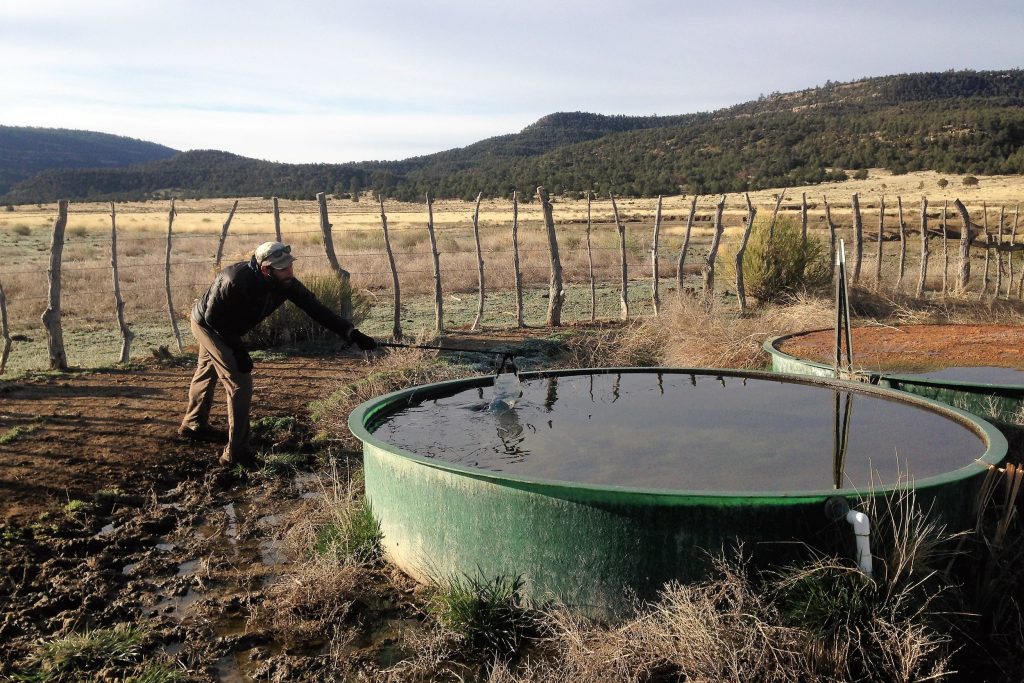
7. Have a Backup Water Filter
Desert water sources vary widely in type and quality and change drastically based on what time of year it is when you visit. Most backpackers prefer to plan desert trips when the prospect of finding plentiful water is best – usually in the spring when snowmelt from surrounding mountains makes its way down to the desert floor.
Before your trip, study all of the information you can find about the water sources along your route and choose your water filtration method accordingly. Your decision should be based on the potential quality of the sources, and by the volume you will likely be filtering in one sitting.
For those hiking as a couple or a group who expect to filter 4 or more liters at each source, a larger capacity model that requires less pumping like the Platypus GravityWorks is a good option. For a single hiker who needs less, something smaller and lighter like the Sawyer Squeeze should be sufficient. For more recommendations, see our list of the Best Backpacking Water Filters.
Desert water sources are often stagnant and adjacent to livestock. For this reason, we advise always carrying backup water treatment, like chlorine dioxide pills, since filters can easily become clogged and slow with hard use.
In deserts of the U.S. Mountain West at least, stock tanks and ponds are the most common watering holes for both backpackers and animals. Be prepared for water to look, smell, and taste suboptimal. Bring what you need to pre-filter water (i.e. remove the biggest chunkies before passing the water through an actual filter) like a bandana or pantyhose. Also bring what the tools to backflush your filter to restore the flow rate of a gummed up device. If the funk is getting you down, pick up some flavored drink packets to make water more palatable. It is not uncommon to find dead animals in tanks. Just remember, this is an adventure!
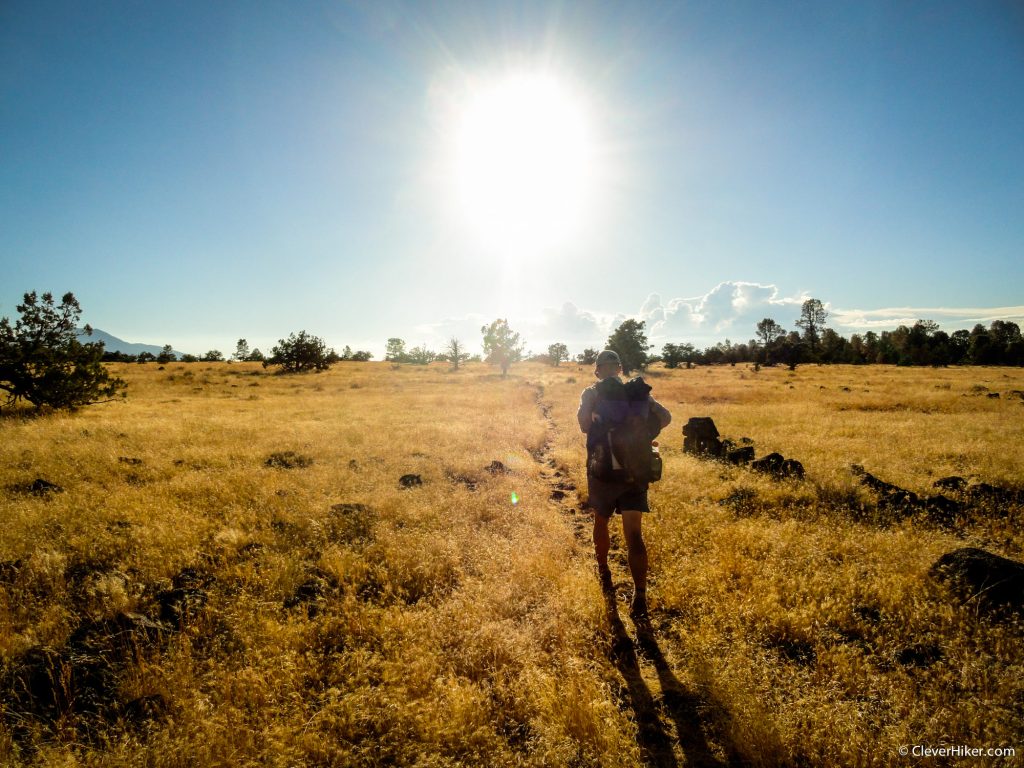
8. Chug at the Source
When you come to a stream crossing, spring, tank, cattle trough, or any good source of water, use the opportunity to drink up. We try to never leave a water source thirsty. Water weighs a lot and it’s much easier to carry it in your stomach than on your back. Especially when you are starting or finishing a long dry stretch of trail, never pass up an opportunity to hydrate. It is too risky to skip opportunities in conditions where some sources may be dry. We are often surprised by how much better we feel after taking a break to drink a liter – dehydration can be sneaky and it’s not always obvious to you in the moment until you are hydrated again.
9. Bring Salty Snacks
You may be more focused on water when you are sweating bullets in the desert, but under those environmental conditions, your body is losing valuable electrolytes as well. Consuming a healthy amount of these minerals (sodium, potassium, chloride, etc.) are crucial for muscle function (avoiding cramping), and cognitive processing.
Energy bars, trail mix, nuts and seeds, dried fruits and veggies, jerky, crackers, and candy are all good sources of electrolytes. Snacking at a slow but steady rate throughout the day helps replenish these essential minerals. Many backpackers also like to add an electrolyte powder to their water.
For backpacking food ideas check out our Lightweight Backpacking Food Guide, our Favorite Freeze Dried Meals, and our Ultralight Backpacking Food video.
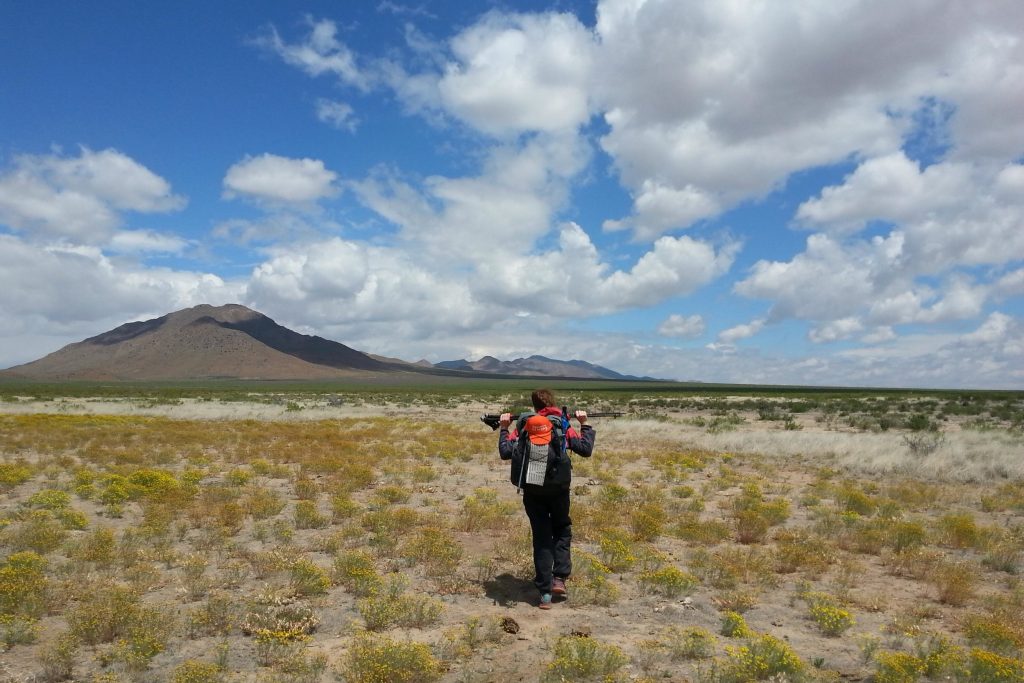
Self-Care
10. Cover Your Skin
Wear breathable, lightweight, light-colored, and loose-fitting clothing when hiking in the desert. We recommend long sleeves and pants to shield your skin from the sun. This sounds counterintuitive to many first-time desert hikers – long sleeves when it’s 100 degrees out!? But protecting your skin from the harsh rays of the desert sun is crucial to your short and long term health and backcountry enjoyment.
If you do prefer wearing clothes that leave skin exposed, slather on plenty of SPF sunscreen and commit to applying it regularly. Watch out for areas such as your face, lips, ears, hands, and neck. It is important to be mindful of the angle of the sun and to monitor your skin throughout the day. If you are starting to feel hot, tender, or are experiencing a burning sensation check for burns and cover up. Getting sunburned can ruin your trip quickly and render your body unable to thermoregulate.
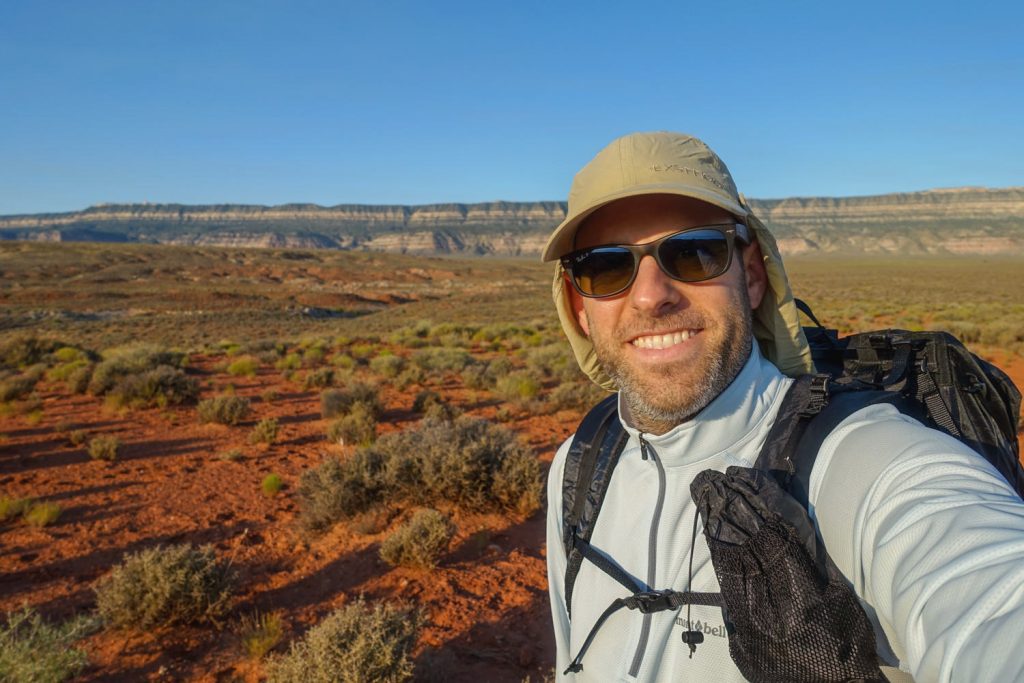
11. Go Easy on the Eyes
Protecting your peepers from the harsh desert environment is also important. Not to be dramatic, but too much direct exposure to bright sun, heat, dryness, and dust can cause irritation, itchiness, headaches, temporary blindness, and long term damage like sun spots.
Wearing both sunglasses and a hat is an easy solution. The brim of a hat shades you face more broadly and a sun hat with a neck cape protects you even more. Choose one that is breathable, quick-drying, and has a wide brim or long bill that will cut the sun out of your view.
Consider sunglasses with UVA and UVB protection that are comfortable enough to wear all day. Polarized lenses are great for cutting glare and increasing visibility around water, sand, and desert rocks which tend to be highly reflective. Polarized lenses direct some of that light away from your eyes, however they may make it difficult to see your cell phone or GPS screen. Keeping your sunglasses on a strap around your neck will make it more convenient to take them on and off, help you keep track of them, and prevent damage and scratches from falling in the dirt or getting crushed.
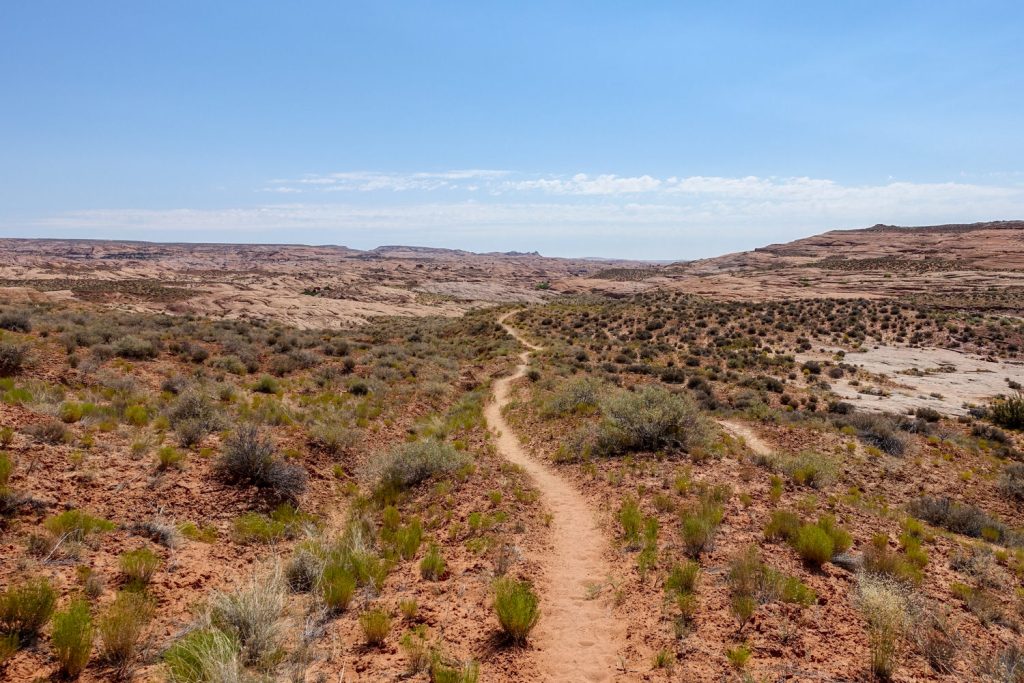
12. Get Some Air Time
Whenever possible, air out your feet during breaks and mealtime. This gives your shoes and socks some time to dry out, which mitigates the chance of blisters and hot spots on your feet. This is also an excellent opportunity to dump out any debris that got into your shoes. If your feet do start to feel a little off, stop and take of it as soon as possible.
In addition, elevating your legs and feet can reduce swelling and speed the recovery of your lower body. Use your pack to prop your feet up and get the most out of your R&R.
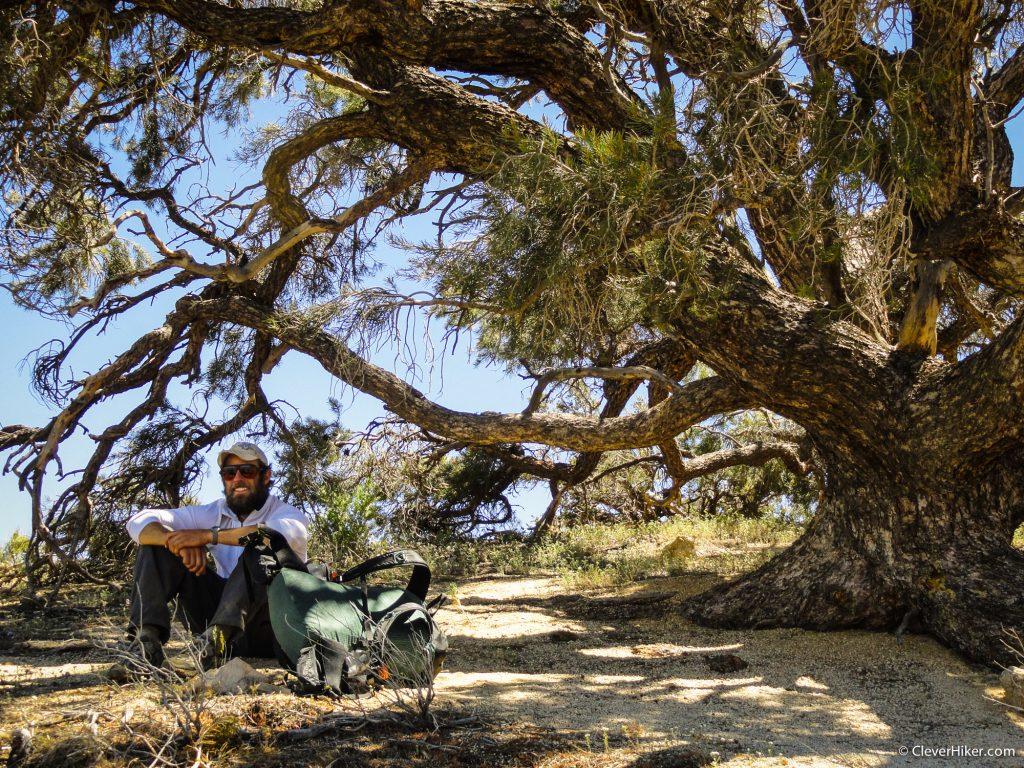
13. Moisturize
The desert is tough on skin – the creatures that live there are scale-y and spiny for a reason. Keeping your skin moisturized will make a world of difference on your hike. If you notice chafing anywhere, take the time to check and make sure there are no folds in the fabric of your clothing under your hip belt or a seam isn’t rubbing in the wrong place. Smoothing out these small details can prevent painful problems down the trail. If you are experiencing chafing or rawness, apply lotion or a sports lubricant to the area before it gets bad.
It’s a fantastic idea to clean yourself up at the end of each day with a quick wipe-down or trail shower. It’s common to develop heat rash and irritation from all the salts left on your skin after sweating. Change out of your sweat-encrusted hiking clothes and into your sleep clothes or base layers once you’re settled for the day. Using coconut oil or another moisturizer on your face, hands, and feet will help maintain healthy skin, and prevent cracking, burning, and blistering.
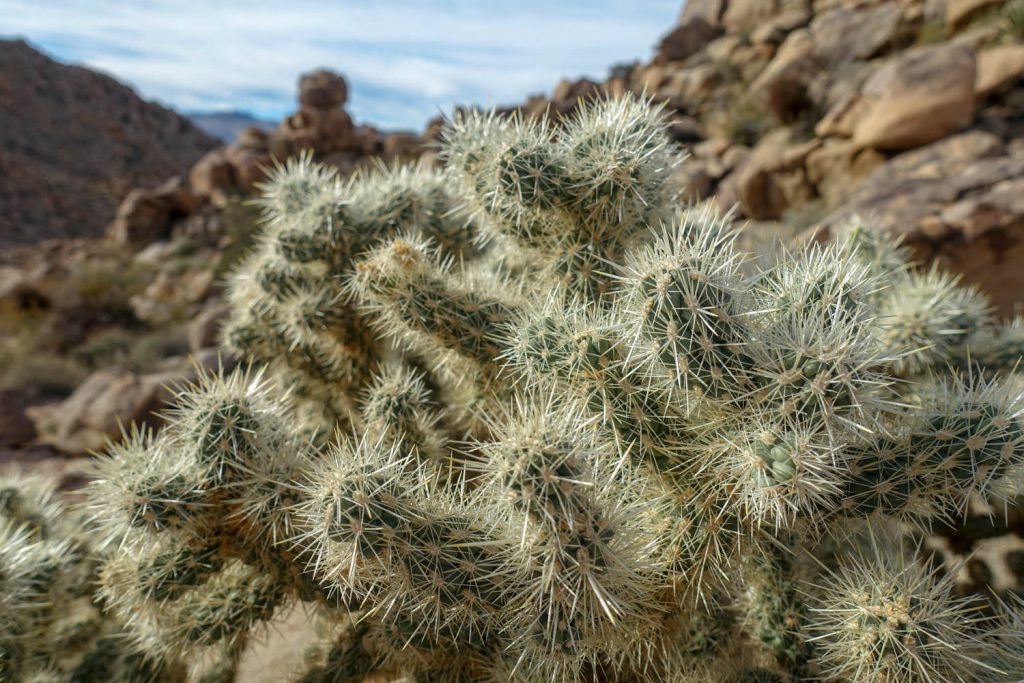
Living Among Pokey Things
14. Be On-Point
A hiker needs only to experience kicking a cactus once to realize it’s worth slowing down and being more aware of their surroundings. There are many species of cacti and spiny plants that can make your life difficult if you tangle with them. Always wear your shoes while walking around in camp. And take care in where you step, sit, and set up your sleeping area in the desert.
Try to select a campsite that gives a wide berth to any cholla, prickly pears, yucca, or agave and look closely at the ground where you plan to set up camp, clearing away any loose spines.
Being diligent will save you from pain a frustration. That being said, deflated sleeping pads can happen no matter how careful you are and wherever you travel. Always carry a small patch kit (or Tenacious Tape) if you use an inflatable sleeping pad and use a ground cloth (or Tyvek) under your tent or pad to help protect it.
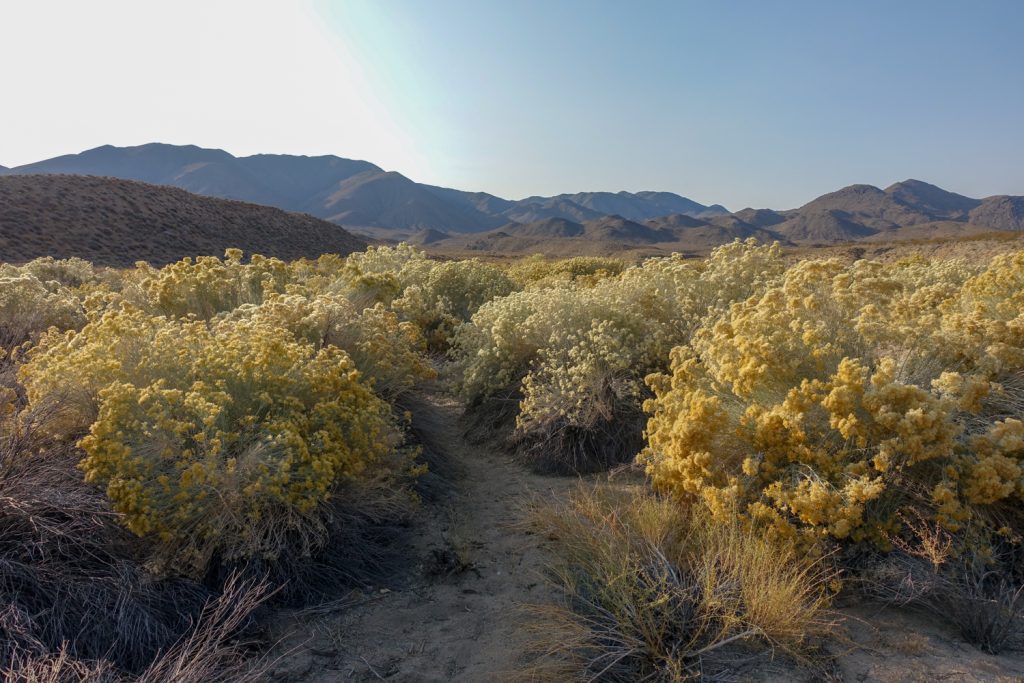
15. How to Remove Cactus Spines
The spines of most cacti species don’t produce any liquid irritants that would require professional treatment, however, a scrape with a cactus is painful and can be debilitating depending on the location.
Some folks resort to using duct tape to try to remove these, but a better method is to use tweezers. A small pair of tweezers like those on the Swiss Army Classic Knife are worth their weight in gold when traversing the desert. If you have a medium or large spine lodged in your skin, grasp the spine close to the skin to avoid breaking it further up its length. Using a slow and firm motion, pull the spine out with the tweezers.
Small spines densely packed into globules on certain cacti species are called glochids. If you bump into these spines, dozens and even hundreds of spines can enter your skin. Although you can use a pair of tweezers and a magnifying glass to remove some of them, it is a painstaking process. To make this process fast and easy, use tape to pull the glochids from your skin. You may have to repeat this process multiple times to get ‘em all.
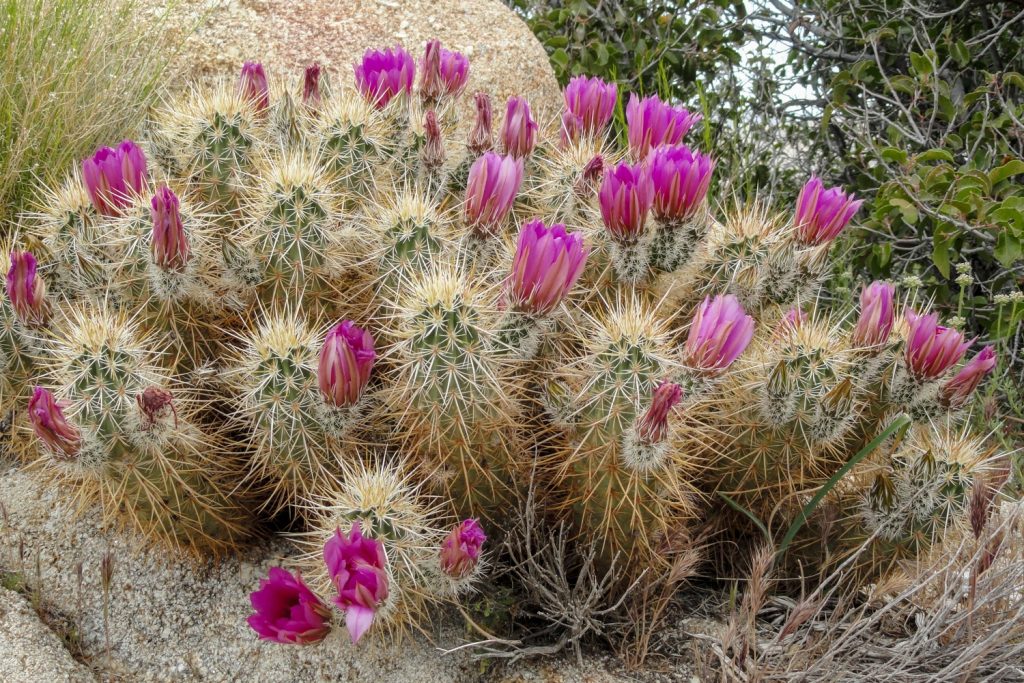
Snakes
16. Keep One Ear Open
Rattlesnakes are common in the deserts of the southwestern U.S. It is normal to be a little nervous about hiking in places where poisonous snakes live, and it is good to be cautious around them. However, the likelihood of having a deadly encounter is extremely low. The possibility of seeing rattlesnakes in the wild can be thrilling and exciting and should not deter you from hiking in the desert.
Rattlesnakes typically are not looking to bite humans unless they are provoked. They almost always give fair warning when you surprise them. Remember, you are much bigger than they are, and they are nervous about your presence too. Snakes strike if they feel cornered or threatened. If you give them space and leave them alone, you can both get back to your own business.
Know when you are in snake country and don’t wear headphones in both ears. While it is very popular with some hikers to wear headphones to listen to music or podcasts to help pass the miles, it is important that you can listen for warnings given by snakes. To learn more, check out our video on snake safety tips.
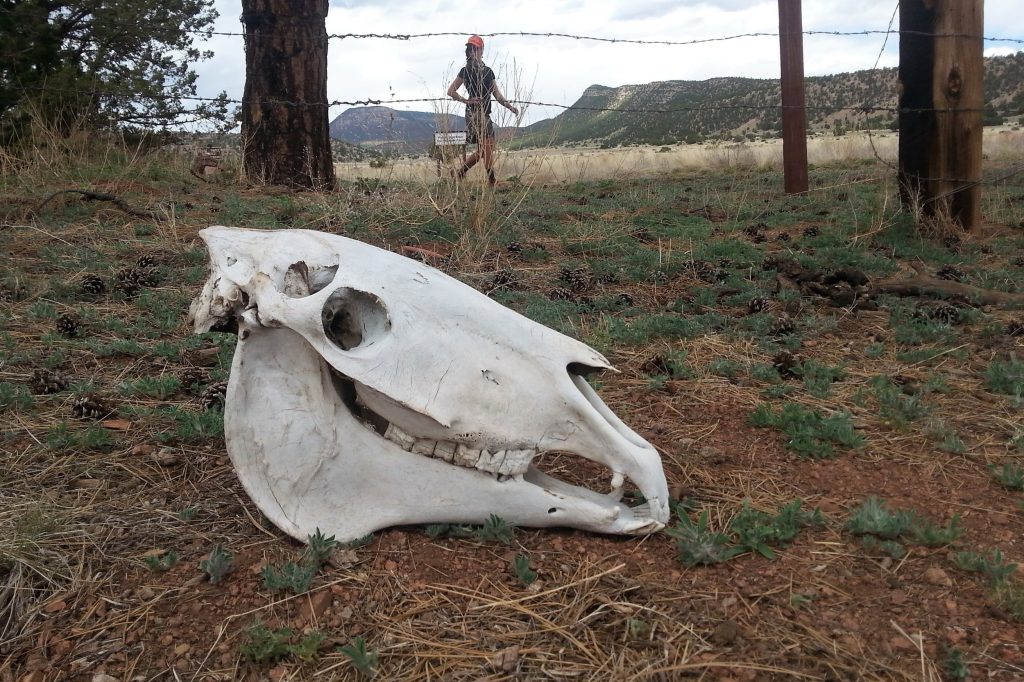
Pack Light, But Not Too Light
17. Go Ultralight
It’s a good idea for a few reasons to pack as light as possible. In the desert, you may have to carry a lot of water. Minimizing your base weight (everything you carry minus consumable items), will give you the flexibility to carry sufficient water through long dry stretches without exceeding your pack’s weight limit.
Bring a minimal shelter, sleeping bag/quilt, sleeping pad, backpack, and lightweight clothing. We have a ton of resources on this subject if you need help, including a video series on the basics of ultralight backpacking gear and a full backpacking gear guide with all our favorite ultralight products.
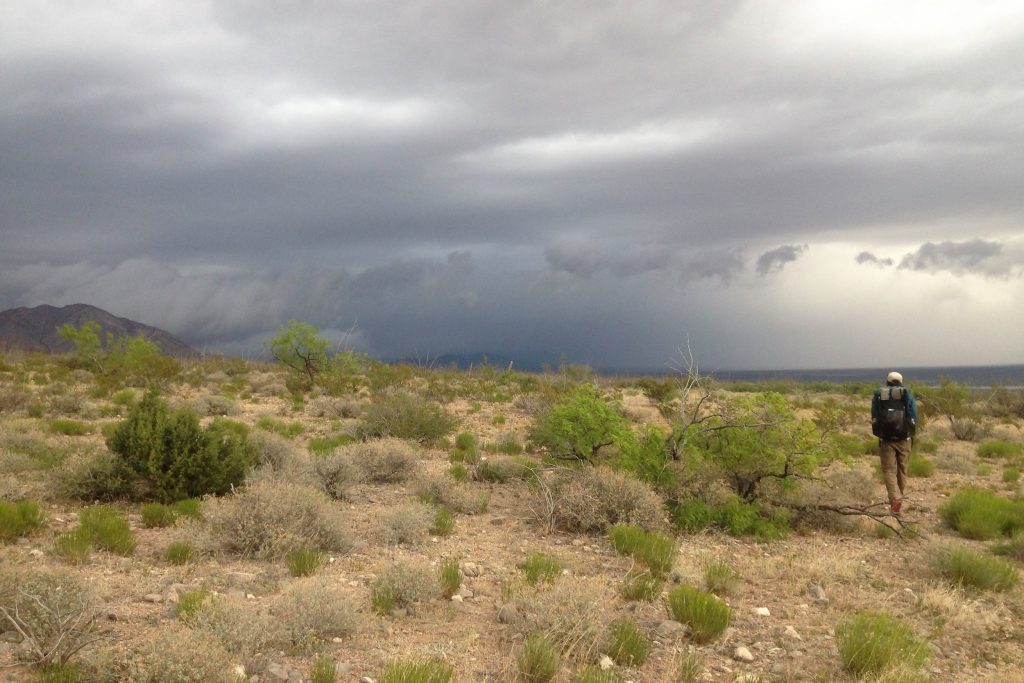
18. Expect changing weather conditions
While it is important to get your pack weight as low as possible for ease and comfort, it is equally as important to be prepared for extreme weather conditions.
Desert temperatures can fluctuate by as much as 60 degrees from daytime to nighttime. The lack of humidity and cloud cover allows the warmer air to rise into the atmosphere while cooler air settles in its place very quickly.
Bring layers including a lightweight puffy coat, pair of fleece or wool gloves, and lightweight warm hat for cold mornings and evenings. The coat will make an excellent pillow when stuffed into the right size stuff sack as well.
In spring and summer, desert storms called monsoons can happen almost daily. Thunderheads move in quickly, dumping heavy rain and hail for several hours before moving on. Always be ready for rain, high winds, and lightning even if the forecast calls for good weather. Having lightweight rain gear and a pack liner to protect your dry sleeping bag and clothes could save your life.
Due to the extreme temperature swings and the possibility of fierce storms in the desert, you should know the signs of both heat stroke and hypothermia. Do not sacrifice your safety by going out underprepared. Know yourself, do your research and practice hiking in different environments. Being prepared for all these weather variables can be a challenge, but, with a little experimentation, you will find what works for you.
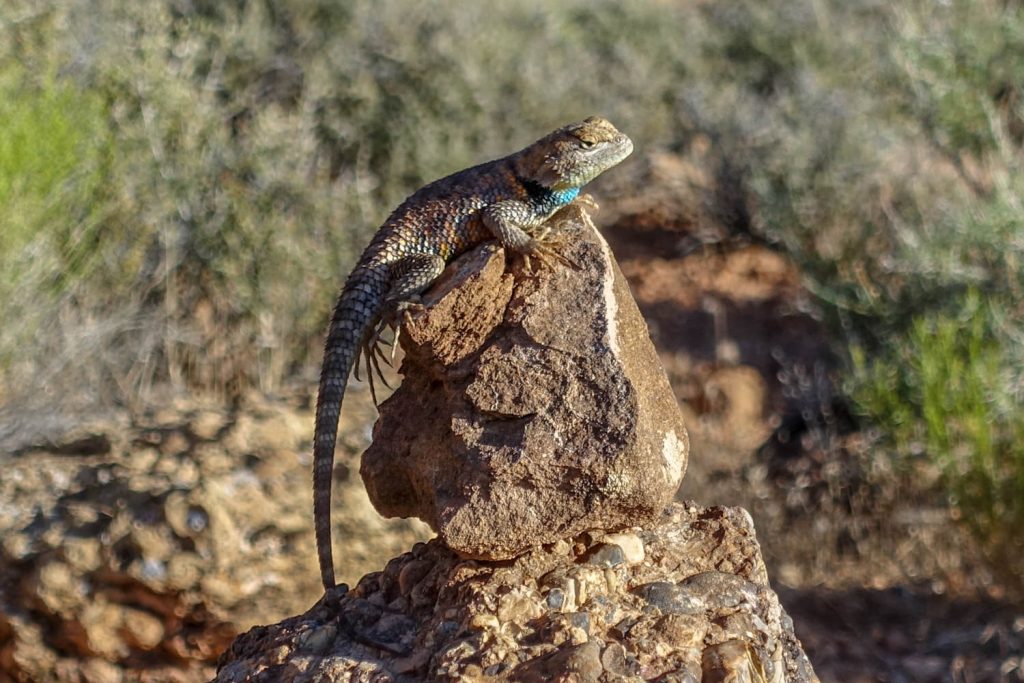
Desert Navigation
19. Master the Map and Compass
Finding your way in the desert can be difficult, but with the proper tools and skills, it can be a lot of fun and very rewarding.
Due to the remoteness of many desert areas, there are few trail crews to establish trails, and visual footpaths are sometimes hard to come by. Therefore, it’s important to have a good grasp on basic map and compass navigation before setting out into these often trailless landscapes.
Since many desert hikes traverse vast, featureless plains, it is useful to use a compass to shoot a bearing in the direction that you want to go and keep checking it as you move forward. Be aware of the topography around you and make a mental map of where you’ve been and where you are headed (as well as marking your location periodically on a physical map and keeping a log of your decision and direction of travel throughout the day).
Wear a watch or something to keep track of the time, as it essential to be able to dead reckon – know how far you’ve traveled within a certain amount of time. The average hiker walks between two and three miles per hour. Time yourself hiking for an hour at an average pace and keep that number in mind.
Cross-country navigation is easy to learn and will give you the freedom to explore and create your own routes. Once you master the basics of shooting a bearing, triangulating, and reading a map, you will feel empowered to make your own tracks and choose any course you find appealing, which is why desert hiking is truly an adventure. Just remember, this is only appropriate in places where the surfaces are durable and you are not trampling plants or trespassing. As always, please follow LNT principles.
Check out our videos on Navigation Skills (episode 6 & episode 7) to brush up and get ready for your trip.
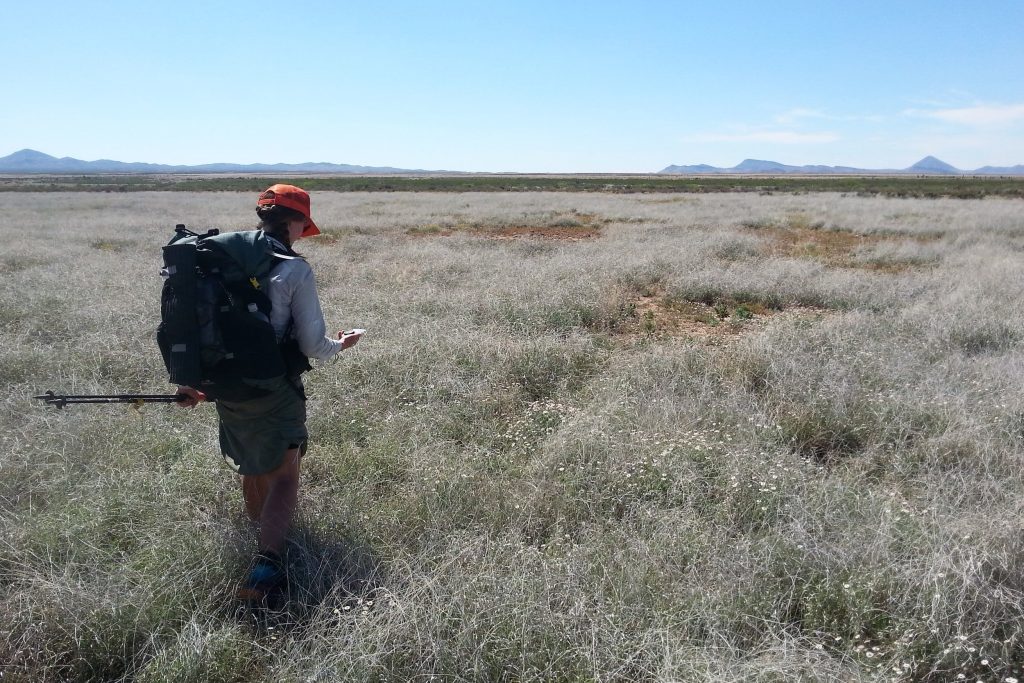
20. Download a GPS App
Even if you are an experienced navigator, we recommend downloading a GPS app for your phone, like Gaia GPS, Atlas Guides, or Topo Maps Plus.
These apps are accurate and add a layer of redundancy to your navigation arsenal without adding any extra weight, (assuming you’ll be carrying your phone already).
Keep track of how far you’ve come, how far you’ve got to go, elevation profiles, and route options at a glance. Some GPS apps, like FarOut, allow other hikers to add comments in real time, keeping you updated with information on water sources, campsites, and more.
You should always carry (and know how to use!) a compass and paper maps in case batteries fail or you drop your phone in the drink, but this old-school/modern tech combo should have you 100% covered and totally geeking-out on all that fun trail data for hours.
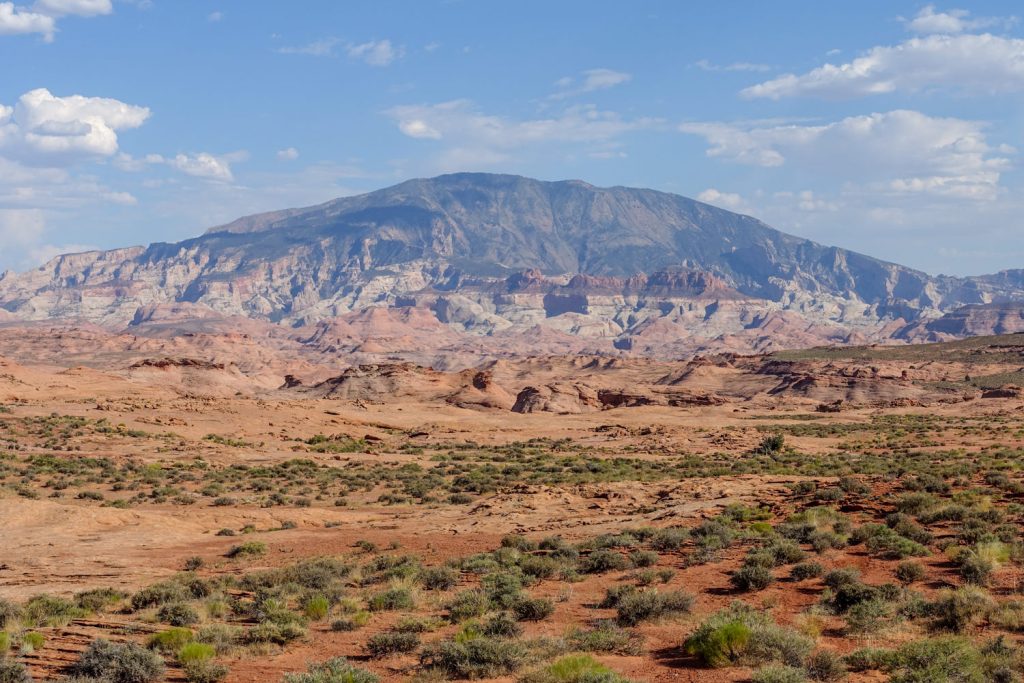
Get Out There & Have Fun!
The desert is both harsh and stunningly beautiful. It’s hard work and it takes endurance to backpack in the desert, but being rewarded with mystery, excitement, surprising beauty, and the feeling of intense gratitude make it worth the hardship. So
go lightly. Be prepared. Be safe, and make some memories. Desert trails are waiting for you!



